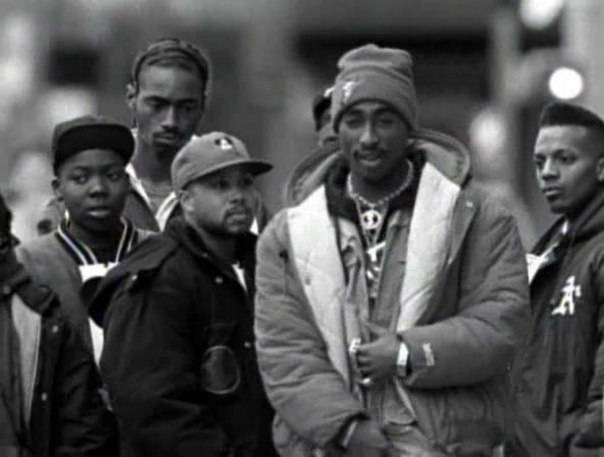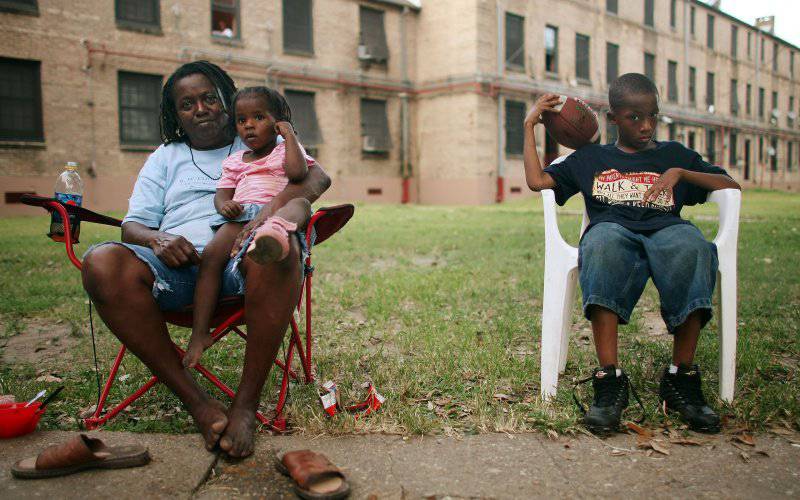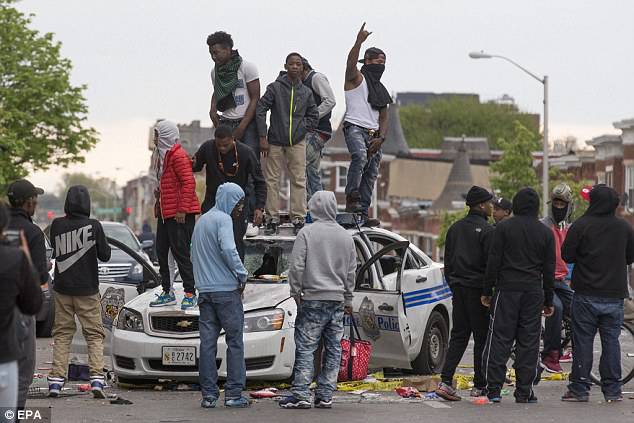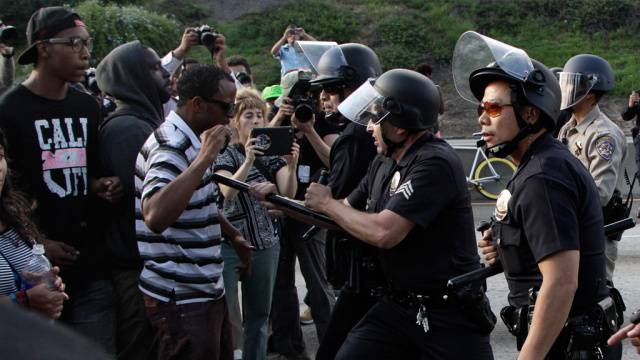Black life of Black America. Racial overtones of social inequality in the United States
Of course, Donald Trump's words are just words. In an attempt to gain support for African-American voters, Trump will continue to promise them to improve their lives if they win the election. But as for the social status of the African-American population, there is no doubt about the truth of Mr. Trump’s words. African Americans are indeed a socially disadvantaged group of the American population - and this despite the fact that they are not immigrants, not immigrants or refugees.

Despite the fact that in the United States, the equality of the white and black population is declared in every way, the socio-economic situation of African Americans is virtually unchanged. Moreover, measures to “eliminate discrimination” are almost exclusively outreach. For example, the use of the word "negro" in the United States has become interpreted almost as a crime, as discrimination against blacks, but at the same time millions of African Americans live in total poverty and in order to get them out of this state, the American authorities do not take any steps. Thousands of films with a positive black hero can be made, special tolerance courses can be introduced into school programs, even a black one can be made president of the country — but in the absence of real measures to eliminate unemployment, increase education, increase wages, all these propaganda steps turn into empty air shaking. There is no correlation between black President Barack Obama and the millions of masses of the socially deprived population of American cities. Some experts speak of modern American policy towards the black population as “positive discrimination”. Now, they prefer not to talk about discrimination of blacks in the United States, ignoring the very fact of the deepest social and economic problems that are associated with the situation of the African American population.
One of the most important manifestations of the true social status of African Americans in the US is economic inequality. So far, African Americans, on average, are much poorer than members of other ethnic and racial groups of the American population. This is due to the conservation of poverty in African American communities. Poverty is inherited, poverty delays, becomes a major obstacle to social mobility. Many African Americans have achieved success in the US - they are present in politics, in business, in sports, in culture. But the majority of African-American countries still remain much poorer than whites. And the poverty of the African-American population is growing, not decreasing. This is facilitated by the specificity of the development of the American economy. As the market demand for unskilled labor declines, more and more African Americans who do not have a normal education remain at the top of the eternal unemployed. If in 2000 the median income of an African American household was 64% of the household income of white Americans, then eleven years later, in 2011, it was already 58% of the median income of the white household. That is, the income of the African-American population has decreased by an average of 6%. In four years, from 2005 to 2009, the gap in the financial well-being of African Americans and whites has widened. If in 2005, African Americans had eleven times smaller assets than whites, in 2009 they already had twenty times smaller assets.
Total poverty forces many African Americans to depend on social assistance from government and charitable organizations. At the same time, it is worth dispelling the illusions of some Russians, who believe that the size of social assistance in the United States is very significant, and the majority of African Americans live exactly on benefits. This is nothing more than speculation. In the end, it is profitable for the American leadership, since the entire responsibility for the social and economic situation of black people in this case is shifted from the state to the African Americans themselves - say, the state does everything it can, pays benefits, and blacks are lazy and do not want work. In fact, in the US, approximately 14 million people receive free social assistance. Of these, 65% are children and adolescents. That is, two-thirds of social assistance comes from helping children from low-income families. As a matter of fact, what else can children live for if not for benefits if their parents are either absent or unable to earn? Most of the remaining 35% of recipients of social assistance are women. And this is not only African-American, but also white. There are even more whites - 38% versus 37% African Americans. The remaining recipients of social assistance are representatives of other racial and ethnic groups, including Hispanics, Asians, and Indians.

Economic inequality among African Americans is exacerbated by social inequality. At one time, the famous French sociologist Pierre Bourdieu wrote about three types of capital - economic, social and cultural. Social and cultural capitals are no less important, since it is their possession that allows families to provide education and careers for their children. For the African American population of the USA, with rare exceptions, social and cultural capital is minimal. Nowadays, over 70% of African-American children are born out of formal marriage. It is clear that most of them are then brought up in single-parent families, where the only breadwinner is the mother. For comparison - only 25% of white children are born out of official marriage. Naturally, this fact alone has a huge impact on the social situation of the African-American population, determining the future of most children at the bottom of the social hierarchy of American society.
Social inequality between African Americans and whites is a natural consequence of the discriminatory policies implemented in the first half of the twentieth century. After all, the abolition of segregation in the United States occurred only in the 1960-s, thanks to an active social movement on the one hand, and a complex international situation on the other. In a country that today is trying to impersonate the stronghold of world democracy, a few decades ago, there was officially confirmed inequality of the rights of representatives of different races. Until now, white and black Americans consider themselves to be representatives of different social groups. African-Americans have their own identity, which in some aspects not only does not overlap with the identity of the whole American, but also contradicts it. What is, for example, the mass distribution among black Americans of Islam. To some extent, the acceptance of Islam was considered by many African Americans as a way to emphasize their “otherness”, belonging not to the world of European culture, associated with Christianity, but to the African-Arab world. However, most African Americans still profess Christianity, although many of them belong to purely African American church communities, which also practically do not overlap with the world of "whites."
For African-American culture is characterized by emphasizing the differences between African Americans and whites. To a certain extent, we are dealing with "vice versa racism." The ideologists of African-American social and political movements in the first half - mid-twentieth century. they tried to develop their own concepts, explaining the differences between blacks and whites and even some superiority of blacks over whites. Africans were prescribed a great sensuality, intuitiveness, unlike the representatives of the Caucasians. In the period of the decolonization of the African continent, the ideas of "African exclusivity" were raised on the shield by many politicians who came to power in African countries. These ideas, in particular, suggest a critical attitude to the achievements of European civilization, which is regarded as less humane than the civilizations of the African continent. Of course, the inhabitants of the African-American "ghettos" in the United States do not think about such high matters, but they draw a line of distinction from whites quite clearly. For example, in the midst of African-American adolescents, the image of a school honors student, a guy or a girl plodding over textbooks and linking their future activities with mental work, is not popular.

In African-American adolescents, another model for achieving success in life is more popular, associated at best with a sports or musical career, and at worst simply with crime. Many African-American children, even those who are capable from birth, deliberately do not show diligence in school, so as not to stand out from the general African-American environment and not to conflict with other blacks. About this, in particular, wrote George Akerlof in the work "Economics of Identity." But if white Akerlof could still be reproached with bias, then what about the findings of another researcher - the Nigerian sociologist John Ogbu, who moved to the USA and settled down to teach at the University of Berkeley in California? Ogbu even introduced the term “poor workout syndrome”, by which he characterizes the attitude of African-American children to learning. Moreover, even children from status and wealthy African-American families, who attend prestigious schools attended by representatives of various racial and ethnic groups, do not want to study. “Positive discrimination” also played a role in reinforcing such an attitude to learning - such children expect to go to colleges and universities for the benefits that exist for African Americans, without making special efforts. It turns out that if the children of the African-American intelligentsia reason this way, then what about the slum children?
Economic and social inequalities are combined with the social deprivation of the African-American population of the country. As is known, the percentage of the Negro population in the southern states that were once the strongholds of plantation slavery was the highest in terms of percentage. There is still a very large African-American population in such states as South Carolina, Mississippi, Louisiana, which are considered the most "black" states of the United States. But an impressive number of African Americans live in major cities of the country, primarily in New York. In places of compact residence of African Americans, sociologists report a much worse standard of living than in areas inhabited by white Americans. “Negro quarters” are essentially social ghettos in which total poverty caused by unemployment, street crime, drug addiction and drug trafficking, alcoholism, prostitution flourish.
At one time, the US government tried to solve the problems of the slums in which African Americans lived, and began to build new residential areas. However, African-American high-rise neighborhoods have become even worse ghettos than old slums. Sociologist Sadhir Venkatesh notes that plans to improve the standard of living of the African-American population have actually failed. In the residential areas where African Americans live, the main problems were: overpopulation of apartments, poor and failing infrastructure of public utilities, mass poverty on the verge of poverty. Of course, in new areas there is also a high level of crime and drug addiction.
Social inequality among the African American population is also evident in the health sector. Since most African Americans belong to lower social strata, they simply do not have the money to take care of their health. Plus, the African-American lifestyle doesn’t help to improve medical performance. The average life expectancy of African-American men and women is lower by 5-7 years than the average life expectancy of white Americans. Diseases such as diabetes and hypertension are much more common among African Americans. Over 30% of African-American men and over 41% of women suffer from obesity, which indicates a poor-quality and unhealthy diet. With regard to the level of the spread of AIDS among the African American population, it is approaching the level of African countries. African Americans make up 48% of AIDS patients, while the proportion of African Americans in the total US population is 12,6%. Needless to say that high-quality medical services for the vast majority of African Americans are simply not available because of their high cost, and the culture of caring for their health is not developed in the African-American ghettos. Despite the fact that African-American families have a fairly high birth rate, the crisis of family values in “black” America is much more pronounced. A huge number of children, as we noted above, are born out of wedlock; in fact, a typical African American family is a mother and children or a grandmother, a mother and children.

Periodically, real uprisings of African-Americans break out in the USA, the reason for which, as a rule, is the cruelty shown by the police. As a rule, the state resolves the issues of suppressing such actions toughly and promptly, without disdaining to use military force, including the introduction of tanks on the streets of rioting cities. At the same time, of course, the US authorities completely forget about pseudo-democratic demagogy applied to other countries. However, the violent suppression of protests does not mean that the problem of social and economic inequality of African Americans can be solved in this way. On the contrary, the situation of the African American population has an obvious tendency to a gradual deterioration, which will be especially noticeable after years, given the higher birth rate.
Information